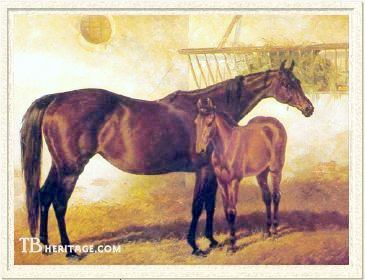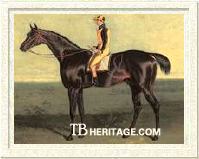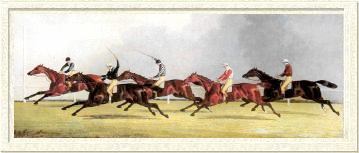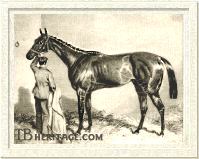|
|
Beeswing

|
|
 |
|
|
During her lifetime Beeswing was one of the most celebrated of British racehorses. Her career was a long and colorful one, as she raced through the age of nine, long after most of her contemporaries had been retired. Her career as a broodmare was not quite as long, but it was just as glorious, as she foaled two classic winners and daughters which carried her blood forward to succeeding generations. To this day, champions and classic winners still emerge which can trace their ancestry directly in the female line to the gallant little British racing queen of the 1830s. |

Dr. Syntax
| |
Beeswing undoubtedly inherited her racing stoutness from her sire, Doctor Syntax, for he, too, was blessed with extraordinary longevity on the racetrack, with his "splendid legs." The Doctor, as he was known on the northern turf, where he ran all his races, won a total of 32 races during his long career, including the Cup at Richmond, which he won five times, the Cup at Preston, which he won seven years in a row, and the Cup at Lancaster, which he won five times. Barely fifteen hands high, "with an eye as full and bright as a hawk," he "...could never bear either whip or spur; but Bob Johnson [his frequent jockey] could always get every ounce out of him by merely stroking and talking to him."
|
Beeswing's dam was an unnamed daughter of Ardrossan out of the Whitworth mare Lady Eliza. Beeswing's mother ran only once, as a two-year-old, and suffered an injury to her stifle, which reportedly left her a cripple for the rest of her life. It did not seem to affect her as a broodmare, for besides Beeswing, she produced Tomboy, a Jerry colt who captured the Doncaster Cup.
Beeswing herself was a small, somewhat delicate filly, topping out at just over fifteen hands when she matured. Foaled in 1833, she was bred by William Orde, a former M.P., who inherited an estate at Nunnykirk, just west of Morpeth, in Northumberland, upon the death of his elder brother. The turf writer The Druid observed that, "With all his turf lore, Mr. Orde had never learnt that bone and muscle must originally go in at the mouth. She [Beeswing] was a well advanced yearling before she rubbed her nose against an oat. She was light-boned, "...owing, in a great measure, to her having been badly kept as a foal." But what the filly lacked in size she more than made up for in heart and courage. She "...was a tremendous kicker in her stall, but showed no vice whatever at the post. She pulled very hard at first, but was, nevertheless, a most delightful mare to ride."
Queen of the Turf
Beeswing's first outing as a juvenile was at Newcastle, where she ran unplaced in the Tyro Stakes. She followed that poor start with a win in the Champagne Stakes at Doncaster, beating the colts St. Lawrence and Jericho, and then ran in a sweep at Richmond, which she also won. Those were her only races at age two.
As a three-year-old, Beeswing won both the Cup and the St. Leger at Newcastle, but was well beaten and unplaced in the classic St. Leger at Doncaster, won by Elis. She also ran fourth in the Doncaster Cup, which was won by that year's Ascot Gold Cup winner, a five-year-old horse whose name would come to be intertwined with hers when she retired to the broodmare ranks, the Marquess of Westminster's Touchstone. The third place horse in this running of the Doncaster Cup, Venison, was a high class colt that had placed third to Bay Middleton in the Derby Stakes earlier in the spring, and had just beaten the previous year's Derby champion, Mundig, in a race at Doncaster. Despite her lack of classic credentials, Beeswing was giving ample proof that she was capable of holding her own against the most accomplished horses of the day.
As a four-year-old in the Liverpool Cup, Beeswing ran second to General Chasse, a horse two years her senior who had, during his career, twice beaten Touchstone and once defeated Mundig. She also finished second to Wedge, a colt belonging to the Duke of Cleveland, in the Craven Stakes at Newcastle. She then reversed that form and beat Wedge easily in two subsequent starts, the Newcastle Cup and the Cleveland Stakes at Doncaster. Beeswing also won the Gold Shield at Doncaster, which was run in place of the Doncaster Cup. She finished her season with a walk-over for the Northallerton Gold Cup.
By this time, Beeswing had become a great favorite with the public. She had proven herself to be a tough and genuine performer, and she always gave everything she had. She continued her winning ways at age five in 1838. She won the Cup at Catterick Bridge as well as the Newcastle Cup. She also captured the Craven Stakes. But as seemed to be her pattern, she saved her best performances for the fall meeting at Doncaster. There she won the Fitzwilliam Stakes and ran second to that year's St. Leger winner, Don John, in the Doncaster Cup. Another offspring of Dr. Syntax, The Doctor, finished third and a four-year-old named Melbourne, destined to be an influential stallion when his racing days were done, brought up the rear. Beeswing closed out her season with walk-overs for the Queen's Plate at Lincoln and the Northallerton Gold Cup.
The next year Beeswing was six, and showed no sign that her form was falling off. She again won the Craven Stakes, the Newcastle Cup for the second year, the Queen's Purse at York, defeating Melbourne, and the Cup at Stockton, beating the three-year-old Ararat. Beeswing also captured the Queen's Plate at Richmond, and the Fitzwilliam Stakes at Doncaster for the second year in a row. Walk-overs were accorded to Beeswing for the Queen's Plate, for a Cup at Lincoln and for the Cup at Richmond.
Mr. Orde's aging little mare returned to the races at age seven in 1840, again winning the Craven Stakes, after having been forced to a dead-heat by the Physician colt Dr. Oliver, three years her junior. She won the Ashton Stakes and the Lancaster Cup at Lancaster, the Cup at York and another running of the Fitzwilliam Stakes at Doncaster.
The finest performance of Beeswing that season was in the Doncaster Cup, the description of which in the October, 1840 issue of Sporting Magazine,gives the full feel of the event: "They got off to a good start, Vermilion in front making the running, as best she could, for Charles XII. She led all the way for over a mile and a quarter, where Charles XII took the lead, considerably increasing the speed, Beeswing following him second...Charles XII held his lead to the distance, when Beeswing and The Provost overhauled him, the old mare coming away several lengths from her horses, and winning very easily, thus proving herself the very best mare in the kingdom."
She followed this impressive win, with racing at Kelso, where she ran second to the good colt Lanercost by a head. At that same meeting, she dead-heated in a two mile race against Lanercost over two miles, and when that colt's connections opted not to contest the race-off, Mr. Orde's mare was allowed to walk-over to officially win the race and the purse money. Later that same day, she won a £50 purse over 2-1/4 miles from The Doctor and Dr. Caius. All told, the amazing mare raced 4-1/4 miles that day.
In 1841 Beeswing was an older mare of eight, and many of her contemporaries had long since retired. But Mr. Orde kept on with her. She appeared in many of the same northern races she had run in previous years, placing second in the Craven Stakes at Newcastle, and winning, among others, the Newcastle Cup, Stockton Cup, the Hornsby Castle Stakes, and the Doncaster Cup.
|

Beeswing enroute to her 1842 Ascot Gold Cup win at age 9 |
Finally, at the age of nine, Beeswing competed in her last racing season, and despite her advanced age, it proved to be her most glorious. Another victory in the Newcastle Cup was nicely sandwiched between two of the finest performances of her tremendous career.
At Ascot, she contested the Gold Cup for the first time, and she displayed an amazing amount of courage in her performance: "She ran clean away with Cartwright [her regular rider for most of her career], keeping her field in hot pursuit....At the Stand, The Nob and St. Francis, one on either side, challenged Beeswing at the same moment, but the gallant old mare gamely shook them off, beating The Nob by half a length, who beat St. Francis by the same distance. It was altogether a fine sight from start to finish."
Her turf farewell came at Doncaster, the place where she always ran her best. The Doncaster Cup was her swan song, and against an old rival, Charles XII, she turned in a thoroughly dominating performance. Beeswing took the lead from the beginning and never looked back. She cruised the over two mile distance like it was no work at all, and won by six lengths.
|
|
Beeswing's Race Record
|
| Year |
Age |
Starts |
1st |
2nd |
3rd |
Unplaced |
| 1835 |
2 |
3 |
2 |
0 |
0 |
1 |
| 1836 |
3 |
5 |
2 |
1 |
0 |
2 |
| 1837 |
4 |
8 |
6 |
2 |
0 |
0 |
| 1838 |
5 |
8 |
6 |
2 |
0 |
0 |
| 1839 |
6 |
11 |
11 |
0 |
0 |
0 |
| 1840 |
7 |
13 |
11 |
2 |
0 |
0 |
| 1841 |
8 |
10 |
9 |
1 |
0 |
0 |
| 1842 |
9 |
5 |
4 |
2 |
0 |
1 |
| Total |
-- |
63 |
51 |
8 |
1 |
3 |
| |
Beeswing had done enough. The tough little daughter of Dr. Syntax, hailed as the greatest mare in Britain, was retired to stud at the ripe old age of nine to begin a new life as a broodmare.
During her racing career, she started 64 times and won 51 races. She won the Newcastle Cup six times, the Craven Stakes and the Fitzwilliam Stakes three times apiece, and the Doncaster Cup four times. When taken home to Nunnykirk after her final season, the entire town of Morpeth turned out to greet her, and a local pub was re-named in her honor.
|
Beeswing in the Stud
The career of Beeswing as a broodmare was no less exemplary than her career as a racer had been. She produced four top class runners, two of which were classic winners. Her first mating was to Sir Hercules, and the resulting foal of 1844 was a chestnut colt named OLD PORT. Unfortunately, he inherited none of his mother's ability. An entry for the 1847 Derby, he finished far down the course in the race won by Cossack.
Beeswing's next foal was her first by Touchstone. The Marquess of Westminster's brilliant horse, who met and bested her in her first Doncaster Cup, was fast becoming the most influential sire of the mid-19th century . While Beeswing was still racing, Touchstone had retired to the stud and had already put three future classic winners on the ground --Orlando (1841), Cotherstone (1840), and Blue Bonnet (1839). His union with Beeswing yielded another one, a black colt named NUNNYKIRK foaled in 1846, named after the place he was born. Nunnykirk, in the colors of Anthony Nichol, captured the Two Thousand Guineas Stakes, and then ran unplaced for the Derby won by The Flying Dutchman. Beeswing's son rebounded in the St. Leger at Doncaster, where his mother had always run so well, and finished a strong second to The Flying Dutchman. Nunnykirk was sent to France in 1851.
|
|
Beeswing's Foals
|
| Year |
Name |
Sire |
Notes |
| 1844 |
Old Port, ch. c. |
Sir Hercules |
|
| 1846 |
Nunnykirk, bl. c. |
Touchstone |
Won 2,000 Guineas, 2nd St. Leger |
| 1847 |
Bonnie Bee, b.f. 1847 |
Galanthus |
|
| 1848 |
Newminster, b. c. |
Touchstone |
Won St. Leger, Twice leading sire |
| 1849 |
Norham, br. c. |
Birdcatcher |
|
| 1850 |
Honey-dew, bl. f. |
Touchstone |
Won Newcastle's North Derby |
| 1851 |
Honey-suckle, br. f. |
Touchstone |
Won Park Hill Stakes at Doncaster |
| 1852 |
Unnamed, bl. f. |
Touchstone |
Died |
|
Beeswing's next foal was the bay filly BONNY BEE (1847), by Galanthus. This filly did not make a name for herself as either a racer or as a producer, though she had some descendants that wound up in Argentina.
Beeswing was then returned to the court of Touchstone, and the result yielded another classic champion. This was the bay colt NEWMINSTER, foaled in 1848, and later sold to Andrew Nichol, who also had purchased and raced Nunnykirk.
|

NEWMINSTER was twice leading sire
| |
The Druid compared the two brothers: "Newminster was not so pretty to the eye as his brother Nunnykirk, who had rather slack loins, but a sweet head and sweeter action." Nichol "...thought Newminster the handsomest horse he had ever known, and that his action was his strongest point. He swept along close to the ground with great elegance and power." Clearly the brothers took after their dam, who enjoyed similar praise. Newminster was, however, a colt plagued by physical problems. His feet were often sore, and in addition, he suffered from dental problems for a time.
|
Consequently, his racing career was limited. He was unplaced for the Derby, won by Teddington. His only major success came in the St. Leger, which he won over One Thousand Guineas victress Aphrodite and Two Thousand Guineas winner Hernandez.
At stud, however, Newminster became an extraordinarily successful stallion. He was leading sire in 1858 and 1863 and sired four classic winners: Musjid, winner of the Derby; Nemesis, winner of the One Thousand Guineas; Lord Clifden, winner of the St. Leger; and Hermit, winner of the Derby and himself a leading sire in Britain for seven years in succession, 1880-1886. Another good son of Newminster was Adventurer, winner of the City and Suburban Handicap and the leading sire in Britain in 1874.
Clearly, the union of Beeswing and Touchstone was a golden one, but Mr. Orde tried one more stallion with his prize mare. She was sent to visit Birdcatcher and the result was a brown colt named NORHAM which died young. Thereafter, Beeswing was mated solely to Touchstone, and two more stakes winners followed. The black filly HONEY-DEW arrived in 1850, and she went on to capture the North Derby at Newcastle. Her year-younger sister, HONEYSUCKLE, won the Park Hill Stakes at Doncaster and also finished third in the One Thousand Guineas. In 1852, at the age of nineteen, Beeswing dropped her last foal, a black filly by Touchstone. This filly died before she could even be named. Beeswing was barren in 1853 and died before foaling in 1854 at the age of 21.
All told, Beeswing had eight foals, two of which died young. Of the remaining six, four were by Touchstone, and all four were major winners. Beeswing's fame did not end with her death. She founded a family that has had enormous impact in racing and breeding around the world.
Through her daughter Honeysuckle, the blood of Beeswing has flowed through champions and classic winners, past and present. Honeysuckle, mated to Stockwell, produced a filly named Woodbine, and the latter filly had three daughters which each headed their own important branches of the Beeswing family.
The first of these daughters of Woodbine was Violet, by Thormanby. Her branch of Beeswing's family yielded Derby and St. Leger winner Melton; Oaks winner Mrs. Butterwick; St. Leger winner Singapore, and the St. Simon filly Santa Brigida, who became an influential broodmare for Lord Derby's stud during the early part of the twentieth century.
Descendants of Santa Brigida include the Swynford mare Drift, dam of sire Heliopolis and his sister Sunstream, victress of the One Thousand Guineas and Oaks. A half-sister to these two was the Fairway filly Tide-way, who was a winner of the One Thousand Guineas and dam herself of the Eclipse winner Gulf Stream, by Hyperion. Gulf Stream became three-time leading sire in Argentina. Alcibiades, champion filly in the United States in the 1930s claimed Santa Brigida as her fourth dam, and her family included her son Menow and descendant Sir Ivor, champion in Europe, Epsom Derby victor, and major sire.
The second important daughter of Woodbine was the Neptunus filly Hedge Rose. From her descend an impressive number of individuals which were influential in American racing and breeding. The list includes: champion Pennant and his full sister Cherokee Rose; champion filly Ruffian; champion mare High Voltage; champion Terlingua; Sweep; Sunreigh; Red God; the good little Mahmoud filly First Flight, and leading American stallion Storm Cat. Two recent American classic winners have emerged from this family--Preakness winner Pine Bluff and Kentucky Derby winner Fusaichi Pegasus.
Feronia, a full sister to Violet, was the dam of St. Serf, a good racing son of St. Simon. His three-quarter sister, Atalanta, produced Two Thousand Guineas and Derby victor Ayrshire, as well as his talented but short-lived brother, Troon. Atalanta was also the fourth dam of Havresac II, leading sire in Italy eleven times and broodmare sire of the unbeaten champion racehorse and internationally successful sire, Nearco. Other tail-female descendants of Atalanta include champion American filly Maskette; Kentucky Derby winner Bubbling Over; major producer Dustwhirl, the dam of American Triple Crown winner Whirlaway and his stakes-winning half-brother Reaping Reward; Broodmare of the Year Kerala, and her son, dual American classic winner Damascus..
Beeswing made a great mark as a racetrack performer of the highest class during a long and arduous career, and as a broodmare. In death, she was given a curious memorial. Her celebrated mate, Touchstone, survived her by seven years, dying at Eaton in 1861 at the ripe old age of thirty. His skeleton was set up in a shed near the stallion boxes, and some of the bones of Beeswing were exhumed and placed at his feet. During his lifetime, Touchstone was a king among stallions, and Beeswing his queen.
--Elizabeth Martiniak
|
|
|
|

